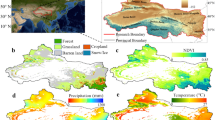
Located across the equator, the East Africa region is among regions of Africa which have previously known the severe vegetation degradation. Some known reasons are associated with the climate change events and unprofessional agricultural practices. For this purpose, the Advanced Very High Resolution Radiometer (AVHRR) version 3 NDVI (NDVI3g) and Climate Research Unit (CRU) datasets for precipitation and temperature were used to assess the impact of climate factors on vegetation dynamics over East Africa from 1982 to 2015. Pearson correlation of NDVI and climate factors were also explored to investigate the short (October - December) rainy seasons. The phenological metrics of the region was also extracted to understand the seasonal cycle of vegetation. The results show that a positive linear trend of 14.50 × 10 −4 for mean annual NDVI before 1998, where as a negative linear trend of −9.64 × 10 −4 was found after 1998. The Break Point (BP) was obtained in 1998, which suggests to nonlinear responses of NDVI to climate and non-climate drivers. ENSO-vegetation in El-nino years showed a weak teleconnection between ENSO and vegetation growth changes of croplands. Also, the analyzed correlations on NDVI data resulted to the higher correlation between NDVI and precipitation than that with temperature. The Hurst exponent result showed that about, 18.63% pixels exhibited a behavior, typical of random walk (H = 0.5) suggesting that NDVI growth changes may eventually persist, overturn or fluctuate randomly in the future depending on the drivers. Vegetation trends with sustainable (unsustainable) trends were 36.8% (44.6%). Strikingly, about 20% of the total vegetated area showed unsustainable trend from degradation to amelioration. More so, results reveal that the vegetation of the croplands (non-croplands) over East Africa changed insignificantly by 6.9 × 10 −5 /yr (5.16 × 10 −4 /yr), suggesting that non-croplands are fast getting reduced Nonetheless, the NDVI growth responses to monthly and seasonal changes in climate were adjudged to be complex and dynamic. Seasonally, the short rainy season showed the higher variability in NDVI than the long rainy season. Also, the DJF, MAM and SON seasons are strongly driven by precipitation variation effect of ENSO versus NDVI series.

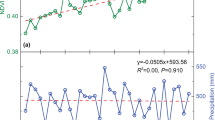

The distribution of terrestrial ecosystems, including composition and mechanism from regional to global scales is heavily dependent on climate 1 . Vegetation cover is a very delicate and unstable portion of the ecosystem 2 . Both the phenological metrics variations and the transformations in vegetation of different land cover types over a particular region are referred to as vegetation dynamics 3 . Vegetation is an important variable in land atmosphere interactions 4 and vegetation changes are considered by the detection of vital phenological quantities, usually the green-up as well as the maturity or the senescence and the length of season (LOS) 5 . There exist a direct connection between vegetation’s density changes, human beings health and hydro-ecological changes. This is to mean the impact of anthropogenic activities as well as natural phenomena such as an El Niño Southern Oscillation (ENSO) 6 .
Causes for vegetation dynamics largely depend on geographical conditions, including the climate constraints together with the inhabitant’s daily activities. The East African economy highly depends on exploiting natural resources; this has direct effects on the abnormally changing climate 7,8 . These changes are shown as the diversion against the normal climatology of the region, obtained by analyzing the long-term recorded data, usually over about thirty years of time 9 . Hussein 8 reported a prediction of warming scenarios from 0.2 °C to 0.5 °C per decade across the African continent while Hulme et al. 10 suggested that under such temperature conditions, equatorial East Africa will possibly indicate about 5–20% increased precipitation in DJF season and 5–10% decreased precipitation in JJA season by 2050. In particular, over East Africa, rainfalls greatly vary during the year, with wider fluctuations occurring over the years and across the two rainy seasons, resulting in socioeconomic and hydrological impacts 11 . The dry season occurs in between the two rainy seasons from June to August 12 . The rainfall modes are majorly influenced by the Indian Ocean’s monsoonal moisture flux, regulated by the north to south movement of the Inter-tropical Convergence Zone (ITCZ) over the Equator 13,14 .
In recent years, satellite sensors have become an important tool for vegetation dynamics and trends at regional to global scales 14,15,16,17,18,19 . The normalized difference vegetation index (NDVI) derived from satellite data is an important indicator that can be used to analyze live green vegetation growth condition, and reveal response of vegetation dynamic to the climate change 20,21,22,23,24,25 . In last three decades, some works are carried out from models and statistical methods which have been used to study NDVI changes in East Africa. Nicholson et al. 26 evaluated NDVI-rainfall relationships in East Africa and the Sahel, and found that the spatial patterns of annually-integrated NDVI closely reflect mean annual rainfall. Pelkey et al. 27 used NDVI imagery analysis to study changes in the vegetation over Tanzania and indicated the increase in greenness during 1982 to 1994. Plisnier et al. 28 used NDVI, ENSO and climate data to study tele-connections between ENSO and ecosystem and their work confirmed ENSO effects on climate and ecological fluctuation. Based on the anomaly of NDVI in East (South) Africa from 1997 to 2000, there was a reversal in NDVI linked between the precipitation traces, changes from El Nino to La Nina conditions 29 .The raising temperature and weakening precipitation, which incited drought and its consequences of the reduced vegetation in Kenya and Tanzania 30 . Recently, Landmann and Dubovyk 31 merged the NDVI data with rainfall records from the Tropical Rainfall Measuring Mission (TRMM) for 2001–2011 over East Africa; the results showed the deteriorating yields as a consequence of both the vegetation degradation and anthropogenic alterations of the land. Detsch et al. 12 applied the FAO Land-cover Classification System (LCCS) over Tanzania of East Africa, and by using MODIS NDVI data from 2001 to 2005, which resulted in the NDVI profiles of different Afri-cover classes were linked to the seasonal variations of the local vegetation, and agreed with rainfall patterns, particularly in the arid zones.
Considering the existent research situation in the region of interest, the aim of the present research work is to give a more detailed and updated analysis of the changes in vegetation in relation with climate and ENSO signals over East Africa from 1982 to 2015. Most of the analyses over the region resulted from regionally averaged and short-term recorded NDVI; previous studies that used long NDVI records ended in 2011. There is a need to understand whether the updated records in AVHRR GIMMS NDVI records indicates any different relationship between NDVI and climate; how NDVI and climate variables fluctuate from their mean position in different ENSO years too. Also, studies over the region did not pay attention to spatial persistence of vegetation trends. Trends can influence data records and appear to be persistent when there is not a real relationship between the data records. Thus, the correct scaling behavior of the vegetation data series has to be well characterized. Thus, the specific objectives of this research are to: (1) study the breaking points in NDVI from 1982 to 2015; (2) analyze the seasonal, monthly and yearly time series of NDVI indices; (3) extract phenological parameters, climatic parameters for short and long rainy seasons, NDVI-climate anomalies as well as the sea surface temperature (SST) anomalies and (4) identify the spatial persistence in trends and the sustainability of the observed trends and also specify the most vulnerable areas over East Africa using NDVI.
This study will be applied to the whole East African Community (EAC) block, comprising 8 countries namely Rwanda, Uganda, Tanzania, Burundi, Ethiopia, Kenya, Somalia and South Sudan (Fig. 1). The study area has a land mass of about 9.8 million square kilometers.
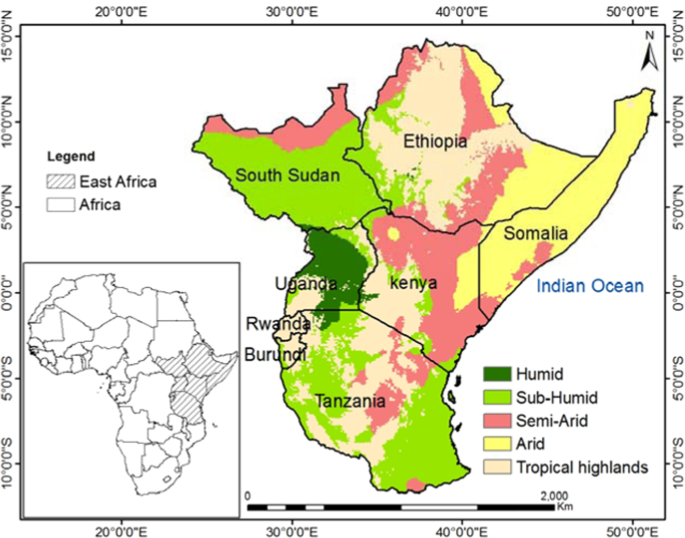
A large part of East Africa experiences two distinct rainfall seasons: “long rains”, which extend during March–May (MAM), and a season with “short rains”, which lasts from October to December (OND). These seasons are linked to the movement of the Intertropical Convergence Zone (ITCZ) northward and southward 32 . East Africa is predominantly semi-arid with an average rainfall amount of less than 800 mm per year; and sub-humid with an average rainfall amount varying between 800 and 1300 mm per year 26 . The vegetation of East Africa is predominantly rain-fed and agriculture has a key impact on the economy of the region, with approximately 80% of the combined population of Rwanda, Uganda, Tanzania, Burundi, Ethiopia, Kenya, Somalia and South Sudan, which depends on agriculture for their livelihood 26 . Most of the Africa’s famous mountains including Mount Kilimanjaro, Rwenzori, Virunga, Kenya and Elgon are located in East Africa 33 . The elevation of the region ranges from 0 to 5895 m above sea level (Fig. 2(a)) and bounded by 14°52′46″N and 11°43′53″S, 24°7′18″W and 51°25′1″E. The region shares its eastern border with the Indian Ocean while the north, south and western borders are surrounded by other African countries. Specifically, the Indian Ocean provides an important route for commercial activities and also serves as a moisture source for the region 34 .
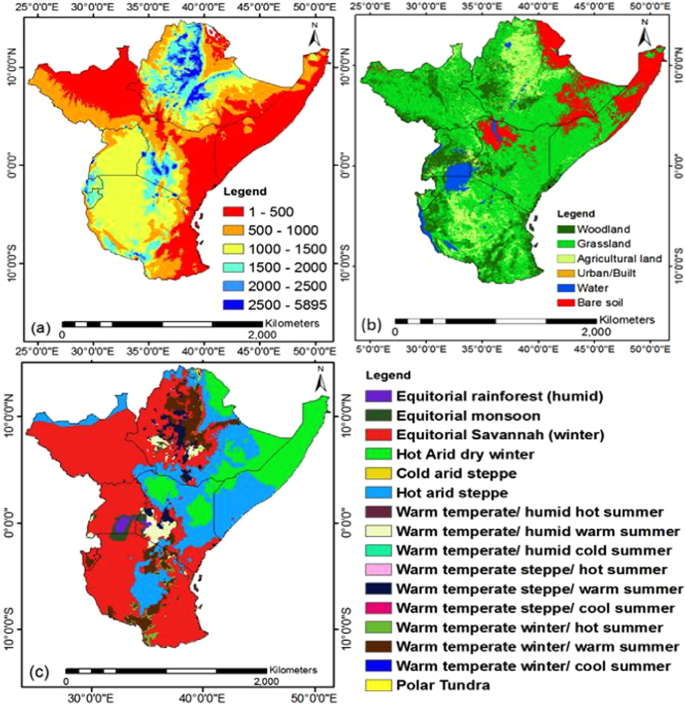
The Normalized Difference Vegetation Index (NDVI) has shown to be a suitable index in characterizing the continental-scale distribution and phenological seasonal dynamics of vegetation 35 . Therefore, we have used the longest available NDVI data records, from the Global Inventory Monitoring and Modeling System (GIMMS) Third Generation (3 g) Advanced Very High Resolution Radiometer (AVHRR) sensor onboard the National Oceanic and Atmospheric Administration (NOAA) satellites 4 at a spatial resolution of 8 km and a temporal resolution of 15 days. The data sets were retrieved from https://ecocast.arc.nasa.gov/data/pub/gimms/3g.v1/ and pixels with annual averages NDVI values less than 0.1 were considered non-vegetated and excluded from analysis to minimize the influence of deserts, and sparsely vegetated areas 36 . The 15-day data was composited into monthly values using Maximum Value Composite (MVC) technique. GIMMS3g NDVI comprises of past NOAA-AVHRR records (0.083° × 0.083° resolution, 1981–2011) which has been recalibrated, and corrects for errors in trends due to calibration loss, volcanic eruptions, and orbital drift.
Climate data records used in this work were gridded observation precipitation and temperature from Climate Research Unit (CRU) of the University of East Anglia (UEA) from 1982 to 2015 at 0.5° × 0.5°. The data sets were downloaded from http://data.ceda.ac.uk/badc/cru/data/cruts/cru_ts_4.00/data/. The CRU records have been widely applied in many studies over Africa. CRU gridded observation data is arguably the most suitable climate data sets as a result of the fact that the region is data sparse. The Koppen-Geiger classification used in this work was retrieved from Köppen-Geiger classifications, following the rules given in 37 as applied to the 5′ resolution WorldClim global climatology (www.worldclim.org; Version 1.4, release 3), were downloaded from the CliMond set of climate data products (www.climond.org).
The Digital Elevation Model (DEM) from the National Aeronautics and Space Administration (NASA) Shuttle Radar Topographic Mission (SRTM) was employed in this work. The NASA SRTM has produced and supplied DEMs for more than 80% of the users all over globe (.http://srtm.csi.cgiar.org/, approx. 90 m resolution).
The land cover map used in this work is based on Global Land Cover Map (GLCM) which are produced from MOD12C4, MOD12C5 (Boston University), GLC2000 (Joint Research Center), Globcover (European Space Agency) and UMD (The University of Maryland), GLCNMO (National Geographical Institute). The GLCM was retrieved from http://db.cger.nies.go.jp/dataset/landuse/data/regional_geotiff/Africa.tif.gz. The Extended Reconstructed Sea Surface Temperature version 4 (ERSSTv4) temperature data was used to study ENSO impact. The data records were retrieved from https://www1.ncdc.noaa.gov/pub/data/cmb/ersst/v5/. The El-nino Southern Oscillation (ENSO) signal is determined via a number of indicators from the Pacific Ocean which include the Pacific Sea Surface Temperature (SST), Southern Oscillation Index (SOI) or Outgoing long-wave radiation, OLR 28 . SOI is referred to as the sea level pressure (SLP) 38 . OLR is important for understanding changes in the Earth’s radiation energy 39 and also used as a signal of tropical rainfall associated to ENSO related convection 28 . According to Anyamba et al. 29 , globally, the climate condition in the Tropics was varied by the most famous ENSO warm event of this century during the 1997/98 period and a shift to cold conditions in 1999/2000.
In assessing the gradual changes in NDVI 40,41 , we used a linear regression model given by Eq. 1 below:
$$where yt represents the NDVI time series, xt is the time span, a and b are the regression intercept and slope respectively for linear model, and γ is the residual of the fit. The slope (b) of the regression indicates the average temporal change and for b > 0, it shows increasing trends and b < 0, it shows decreasing trends.
For a time series xt = 1, 2, 3, … N, a Break Point (BP) is introduced into two consecutive branches of the series by a moving point k, k ∈ 3 + t, t = 1, 2, … N − 3 with a moving step i = 1 and a least-square linear regression model (Eq. 1) is fitted to each of the paired time series segments as shown in Eq. 2 40 :
where yt is the NDVI time-series, xt is the time period, k is the BP time, a and b are the intercept and trend respectively, the subscripts bk and ak are the regression constants for the two paired portions before and after k respectively; and γ is the residual of the fit. More literature about Break Points model can be obtained from Chen et al. 40 , from which the Akaike Information Criterion (AIC) was applied to evaluate the importance of introducing BP in the series.
$$AIC=n\,\log (\tfracwhere R is the residual sum of squares, n is the sample size, and k is the number of parameters in the model in the estimated model. A BP was introduced if the AIC of the piecewise regression was smaller than the ordinary least square regression.
In this work, El Niño, neutral, and La Niña years were chosen based on data from sea surface temperature (SST) anomalies of the tropical Indian Ocean in the region +0.5 °C and −0.5 °C referred to as the Niño 3.4 region. We considered the gridded Extended Reconstructed Sea Surface Temperature version 4 (ERSSTv4) temperature data 42 . For average SST anomalies exceeding +0.5 °C (−0.5 °C) from October to March, the preceding growing season belonged to an El Niño (La Niña) year. The October to March period typically coincides with peak ENSO Conditions Neutral years ranged between −0.5 °C
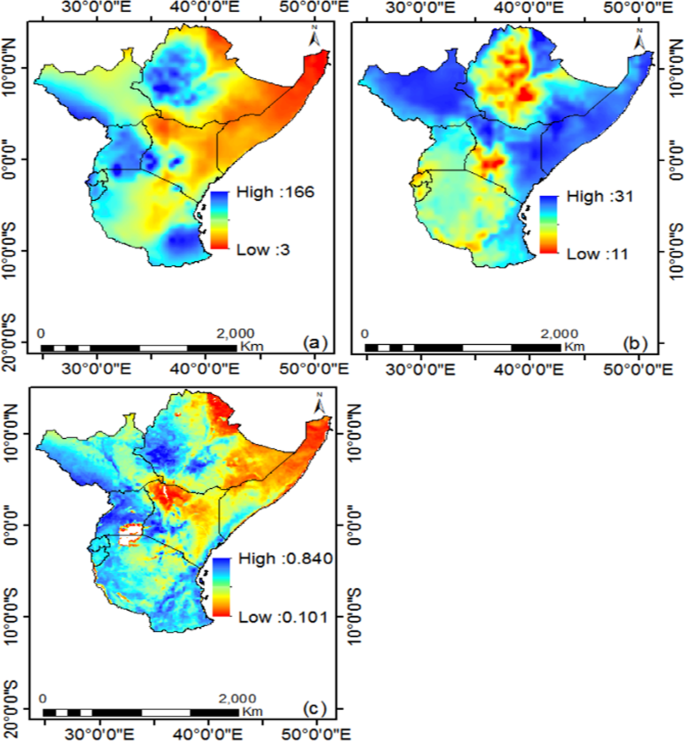
Table 2 shows summary of result computed by using long term averages of NDVI, precipitation and temperature from 1982 to 2015 for El nino, Neutral and La nina years over all seasons. Result shows that El Niño conditions are associated with an overall increase in surface temperatures in all the seasons, with the highest value of +0.48 °C in the MAM season, corresponding to low percentage increases from mean value for both NDVI and precipitation. Also, La nina conditions are associated with an overall decrease in surface temperatures in all the seasons with the lowest value of −0.24 °C in SON season and high percentage increase of NDVI and precipitation MAM season. Basically, the climate of East Africa is influenced by ENSO events, which cause severe extreme conditions, tend to enhance precipitation over the region except in the northern and western parts of the Ethiopian and Eritrean highlands, where drought and floods are prevalent.
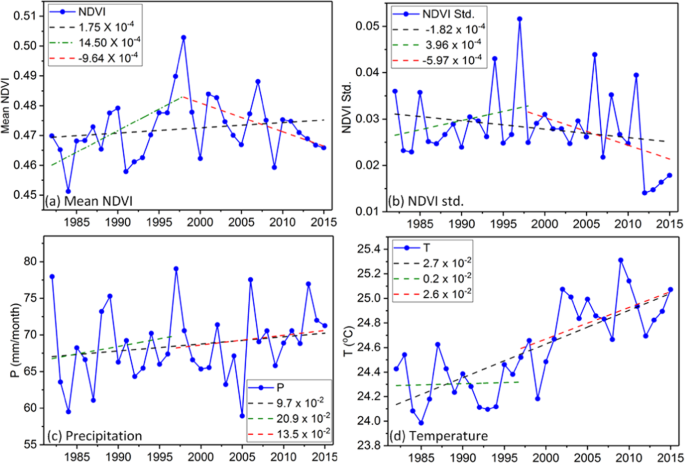
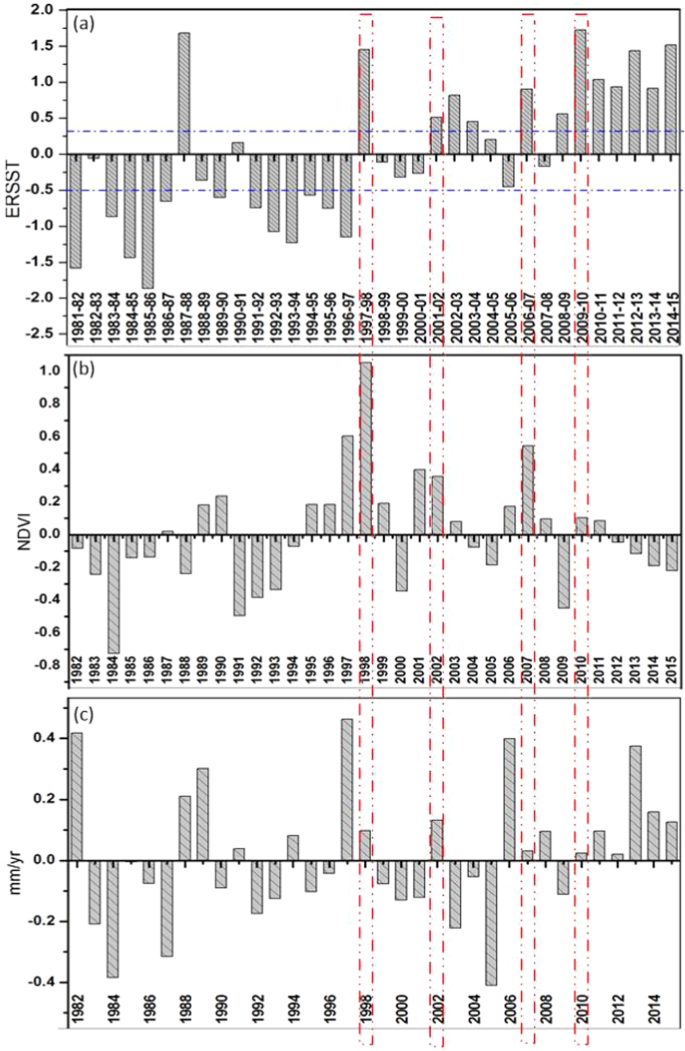
The major flood and drought episodes over the East Africa have been linked to ENSO events. For the 1997/98 event, high SST resulted in high positive anomalies for both NDVI and precipitation while in 2014/15 event, precipitation (NDVI) recorded positive (negative) anomalies. Specifically, the ENSO effect may result in either drought conditions or rain induced cropland damage due to flood. In this work, Pearson correlation of NDVI of croplands from 1982 to 2015 is done in Neutral, El Nino, and La Nina years to study the cropland changes over time (Table 4).

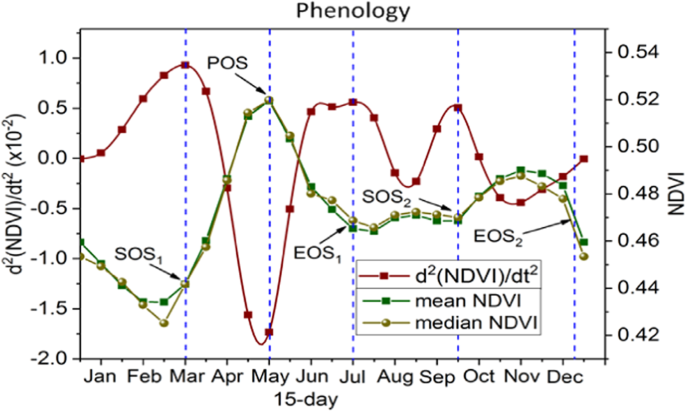
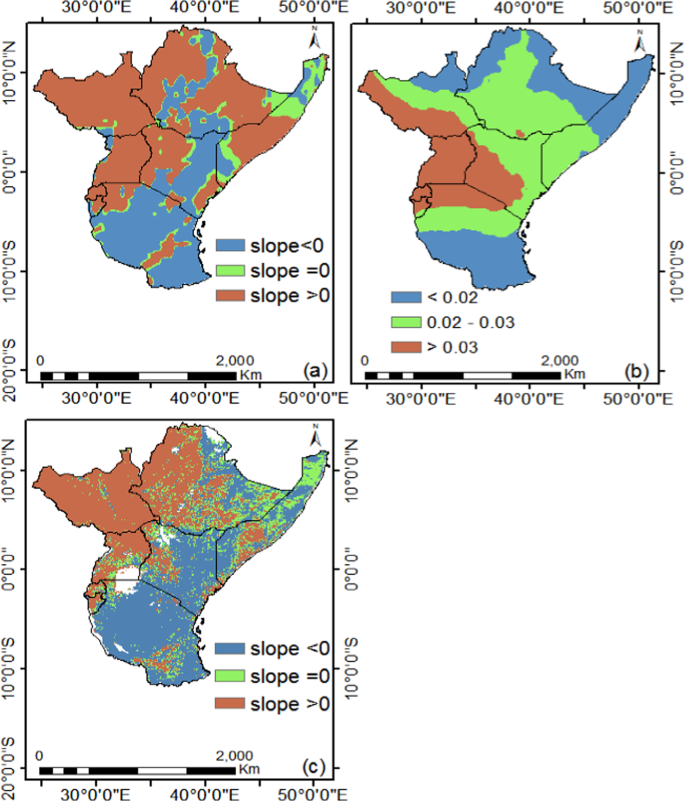
In Fig. 9, NDVI showed positive (negative) relationship with precipitation (temperature) both in the long and short rainy seasons. Also, all the two seasons, temperature is inversely related with precipitation. The diagonal variables in Fig. 9 are the histograms of pixel distribution in NDVI, precipitation and temperature. NDVI pixels in long and short rainy seasons are unimodal and bimodal, respectively. Temperature is left skewed in all the seasons and precipitation is right skewed. The same relationship between NDVI and climate parameters is observed using spatial data records.
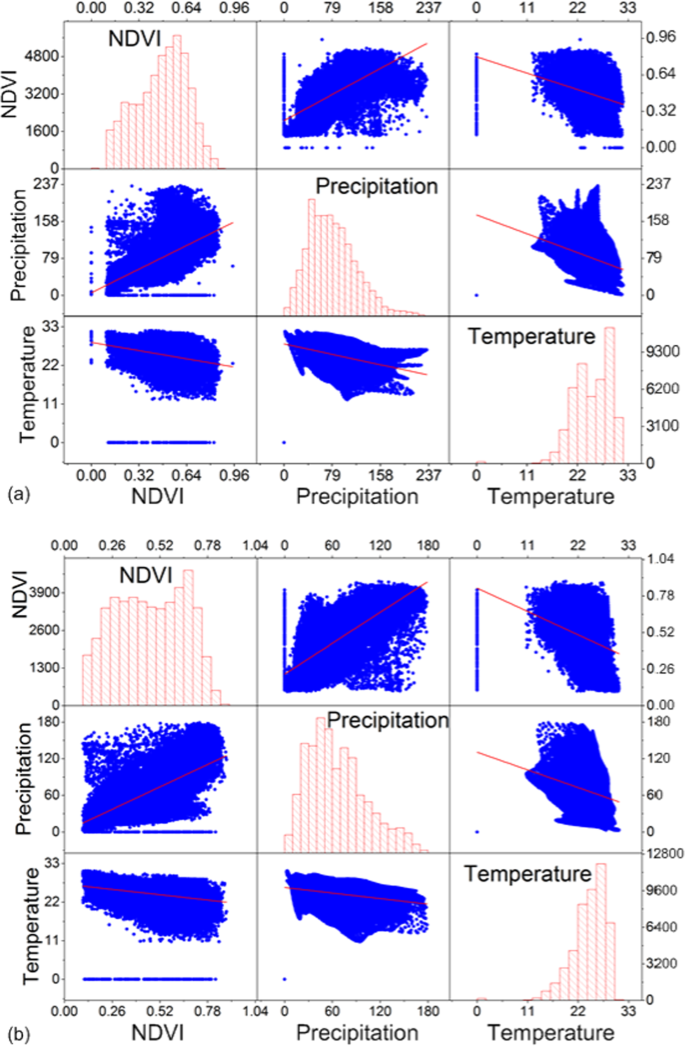
We used Pearson correlation to study the relationship between vegetation growth changes and climatic elements over the region from 1982–2015 (Fig. 10). Generally, NDVI significantly correlated precipitation than temperature. Thus, precipitation influenced vegetation growth changes than temperature. On one hand, correlation analysis of individual seasons across the region shows that 20, 23, 10 and 34% NDVI pixels positively and significantly correlated with precipitation over the DJF, MAM, JJA and SON seasons respectively while about 2, 1, 2 and 2% NDVI pixels negatively and significantly correlated with precipitation over the DJF, MAM, JJA and SON seasons respectively. On the other hand, correlation analysis of individual seasons across the region shows that 10, 5, 0 and 9% NDVI pixels positively and significantly correlated with temperature over the DJF, MAM, JJA and SON seasons respectively while about 2, 11, 10 and 9% NDVI pixels negatively and significantly correlated with precipitation over the DJF, MAM, JJA and SON seasons respectively. Thus, the DJF MAM and SON seasons are strongly driven by precipitation variation.

Most forest regions indicated low NDVI-precipitation correlations but high NDVI-temperature correlations over East Africa. This observation is consistent with the studies by Ndayisaba et al. 35 over East Africa and Igbawua et al. 41 over West Africa. Over the forested areas, the water budget for NDVI is high throughout year which is while NDVI reacts poorly to precipitation. In this case, temperature becomes the limiting parameter over the forested areas. Conversely, precipitation is the limiting parameter in areas with low moisture budget such as the savannas and agricultural lands. The spatial analysis of correlation between NDVI and precipitation has indicated that mean growing season NDVI is better correlated with precipitation in low plains of Eastern region than in high altitude during the short season. Figure 10 revealed that the two rainy seasons have a different mechanism by which NDVI responds to climate parameters. NDVI correlates differently with precipitation/temperature during the long and short rainy seasons. This suggests that the moisture source in each of the season has an influence on the vegetation dynamics over East Africa.
At country scale, the correlation coefficient of NDVI versus precipitation showed that positively correlated pixels were ≥50% of the total vegetated area for both the long and short rainy seasons (Fig. 11(a,b)). Also, during the long rainy season the correlation coefficient of NDVI versus temperature showed that all countries in study area except Ethiopia and Kenya had positively correlated pixels ≥50% out of the total vegetated area. These areas are primarily located in the northern and central part of the study area. For the short rainy season, the correlation coefficient of NDVI versus temperature revealed that all the countries in study area except Kenya, Tanzania and Rwanda had positively correlated pixels ≥50% of the total vegetated from 1982 to 2015 (Fig. 11(c,d)). The research findings have illustrated just like Ndayisaba et al. 35 , that the region which is basically a cool and dry equatorial climate regime (Fig. 2c) has precipitation as the limiting factor for vegetation development. Thus the sensitivity of vegetation to climate change is aligned to precipitation changes more than temperature changes. On the whole, temperature increases may exacerbate surface evaporation and subdue vegetation growth as a result of excessive water loss 46 .
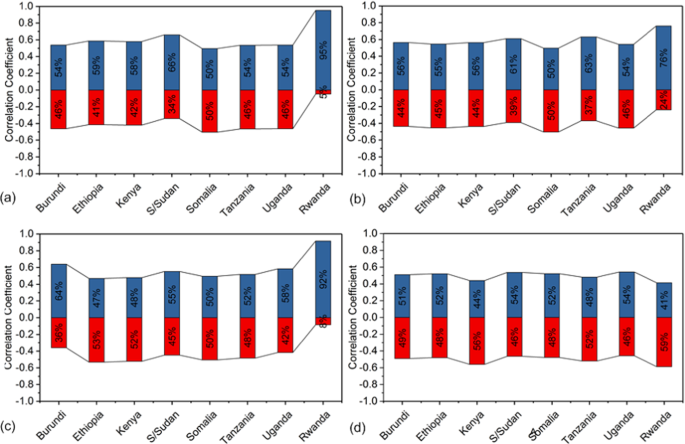
By means of the results for NSC of NDVI and climate data records, the fluctuations in the timing of the seasons and phase changes with respect to the normal annual mean have been quantified from 1982 to 2015 (Fig. 12). On average, rainfall has a higher value for time variation, and followed by NDVI, then temperature. In East Africa, the response of vegetation naturally comes after the seasonal progression of the rainfall 29 . Figure 12 illustrates Normalized Seasonal Cycle (NSC) of NDVI and climate elements, the NSC was computed using Eq. 7. The seasonal mean NDVI and climate factors computed from 1982 to 2015 have shown to exhibit seasonality pattern. Seasonality is more pronounced over the south equatorial region with steady increase during the two growing season time slope. Generally, NDVI shows high values over the south equatorial region than north equatorial region both in the MJJ and NDJ seasons. It can be observed that NDVI shows similar phase changes in the Northern equatorial (NE) region than the Southern equatorial (SE) region of East Africa. In both regions, precipitation shows high variability than vegetation and temperature.
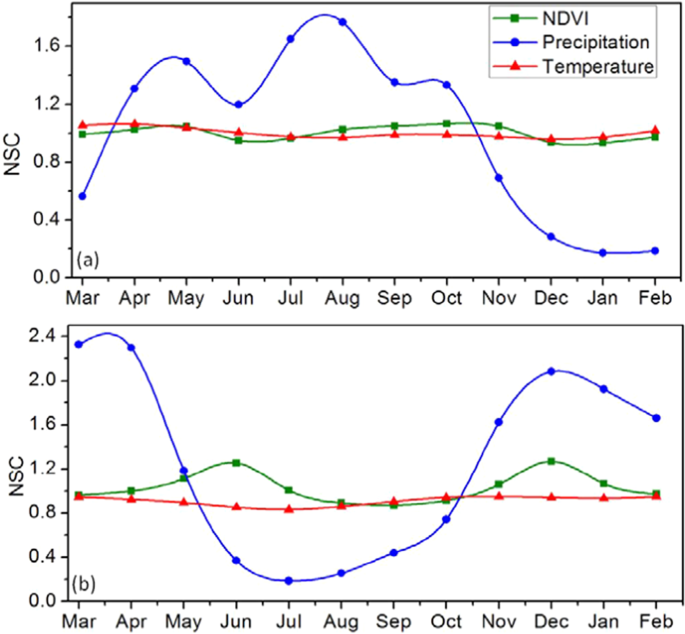
In the NE region, NDVI increases slightly from March, peaked in May decreases in June before increasing again from August to December while in SE region, NDVI increases greatly from March to August, then decreases in September before increasing again from October to February. Over the NE region, low rainfall and moderate NDVI values are found during SOS in MAM season, and they increase with advancement of season while temperature shows slight variation. Both NDVI and temperature shows slight variation from above normal to below normal conditions. In OND season, the changes in temperature are not obvious while NDVI and rainfall shows an abrupt decrease. Similarly, over the SE region, high rainfall and low NDVI values are found during SOS in MAM seasons and as rainfall decreases, NDVI increases with advancement of season. The temperature shows slight decrease in MAM season. In OND season all the variables increased except temperature. NDVI and temperature shows lags of between 1–2 months during the JJA and OND seasons over NE and SE regions. This is because during dry-down, decreasing soil moisture conditions corresponds with increasing surface temperatures and this explains the reason for inverse relationship between NDVI and temperature over the study region. Specifically, East Africa is predicted to experience increased precipitation along with climate variability but surface runoff which is affected by precipitation and temperatures may wane due to increased temperatures 7 .
Also, the NDVI seasonal cycle is partially in-phase with climate variables over NE in MAM and OND seasons. Over the SE, NDVI is out-of-phase with climate variables only in MAM season with lags between 1–2 months. On close inspection in both regions the striking similarity between NDVI and rainfall becomes visible, maximum NDVI values are reached after the rainfall season begins to subside and NDVI is totally out of phase with rainfall. This is as a result of the fact that after rainfall the soil is able to retain most of the moisture and gradually transmit some to the vegetation as the season progresses. Thus, soil moisture is widely recognized as a vital element that connects precipitation and vegetation 52 . According to Nicholson et al. 26 , researches on NDVI in connection to soil moisture would transmit to a more detailed knowledge of the environmental limitations on vegetation growth changes. The set back to this is the non-availability of soil moisture data over the data sparse Africa countries.
The concept of CV was adopted to assess NDVI variability analogous to the mean monthly values, while the standardized NDVI values also known as Z-scores were applied to expunge the NDVI seasonality and to measure the shift of NDVI with respect to the mean-monthly values 45 . The seasonal CV shown in Fig. 13 was analyzed separately to show significant patterns in vegetation variability across the seasons. In Fig. 13, NDVI, precipitation and temperature showed high CV of 5.7, 36.9 and 1.6% in January, December and September, respectively. The CVs of NDVI and precipitation are in the end of the short rainy months as expected except temperature. For low CV, NDVI, precipitation and temperature indicated 3.0, 13.94 and 2.7% in September, July and September, respectively. The low CVs for NDVI, precipitation and temperature fall in between the two seasons.
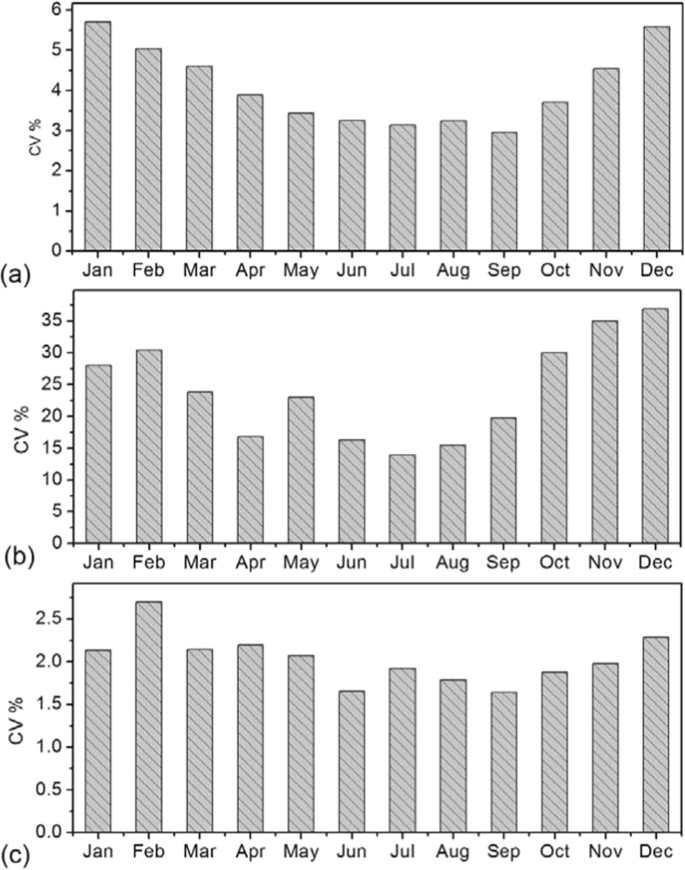
Also, from Fig. 13(a), the CV of NDVI during the DJF season was highest and lowest during the JJA season over-lapping into September, and steadily increasing up to the end of the SON season before decreasing at the end of DJF season. For precipitation and temperature, the DJF season shows a reduced CV in January compared to December and February. In Fig. 13(b), low CV in April is as a result of peak rainfalls over the region and high CV in March and May compared to April describes the variation in precipitation during end of long rainy season. Overall, precipitation shows highest CV followed by NDVI then temperature (Fig. 13). Both NDVI and climate elements displayed an increased CV from September to December, which suggests high vegetation and climate dynamics during the short rainy season. Spatially, NDVI variability increases as one move into the dry land areas with a CV of >50% having been observed in those areas during the long and short rainy season (Fig. 13). The spatial CV appears to show a meaningful idea about vegetation dynamics over the region even though the values are obtained for two different seasons over the last three decades.
The spatial CV indicates that the mechanism of variation is different for the two seasons (Fig. 14). Agriculturist and Pastorist occupy areas that have very favorable climate conditions such as temperature and precipitation patterns which help them to develop. In Africa where Pastorist travel long distances around the grazing corridor, livestock production and maintenance is normally affected by climate variability. Both drought and flooded plains are not ideal for livestock rearing and any effect to vegetation caused by changes in climate affects both the farmer as well as animal. Therefore any change in the climate of such areas can have a lot of effects on the plant community including the animals existing there. They are most affected by the high variability as they rely more on rain fed agriculture and other natural resources affected by climate change over the region 7 .
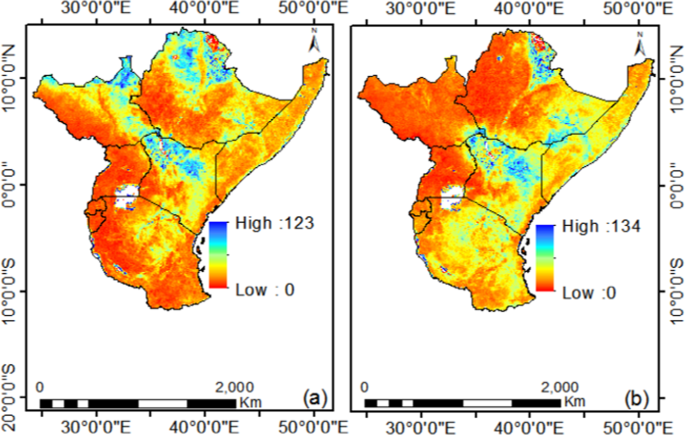
The 34-year remote sensing data of NDVI from the AVHRR sensors over the surface vegetation of East Africa was assessed in detail to study significant patterns in NDVI changes in response to climate change and variability. The results presented that the spatiotemporal vegetation productivity and variation over East Africa vary in different areas and time frames. The linear regression model A and piece wise regression model B are robust for detecting gradual and break points in mean NDVI and NDVI standard deviation, respectively. The negative trends observed in NDVI standard deviation after the BP is as a result of the improved vegetation greening from below normal conditions from 1980s and 1990s to above normal conditions in 2000s and 2010s. Results shows that before the BP, the mean annual NDVI (NDVI std. dev.) increased at 14.5 × 10 −4 /yr (3.96 × 10 −4 ) and decreased significantly for NDVI (NDVI std. dev.) at −9.64 × 10 −4 /yr (−5.97 × 10 −4 ) after the BP. Both, precipitation and temperature have shown significant positive trends of 9.7 × 10 −2 /yr and 2.7 × 10 −2 /yr respectively over the study region from 1982 to 2015. The occurrence of different spatial patterns for break and gradual changes with systematic variations in trends indicates the complexity in vegetation growth changes and a nonlinear relationship of vegetation to climatic changes and other non-climate drivers.
NDVI showed positive (negative) relationship with precipitation (temperature) both in the long and short rainy season. Also, all the two seasons, temperature is inversely related with precipitation. The distribution of NDVI pixels in long and short rainy seasons are unimodal and bimodal respectively. The same relationship between NDVI and climate parameters is observed using spatial data records. NDVI correlates differently with precipitation/temperature during the long and short rainy seasons. This suggests that, the moisture source in each of the season has an influence on the vegetation dynamics over East Africa. For NDVI values of the total vegetated area of East Africa, about 47.0 and 49.1% pixels are increasing and decreasing respectively while less significant amount remain unchanged from 1982 to 2015. The long-term decrease of vegetation as indicated by NDVI is a sign of degradation.
For the phenology metrics, results showed that the long growing season starts in March, peaked in May and in July while the short growing season starts in September, peaked in November and ends in December. In all, NDVI shows lags with precipitation in both the long and the short rainy and this explains the fact that while rainfall stops vegetation activity persist before returning to its dormant condition. Also, the study uncovered some links between NDVI and ENSO during most of the El-nino and La-nina years, specifically 1992/93 and 1997/98. The pattern of high (low) ENSO anomalies in 1998/97 (1992/93) corresponded with high (low) NDVI and rainfall values. The NDVI values during the 1997 (1998) are 1.3% (3.5%) above normal and 1.4% (0.4%) below normal (slightly above normal) in 1992 (1993). The above-normal NDVI was a result of excessive precipitation in 1997 which spilled up into 1998. Specifically, the damage caused by ENSO to vegetation is transferred via precipitation. The detected weak link between mean NDVI and ENSO suggests that there may be a weak teleconnection between NDVI and ENSO. The effect of ENSO on NDVI series is pronounced when vegetation is considered in seasons before actual months, suggesting a time lag between them.
This work was supported by the CAS Strategic Priority Research Program (No. XDA19030402), the Key Basic Research Project of Shandong Natural Science Foundation of China (No. ZR2017ZB0422), Shangdong Key Research & Development Project under Grant 2018GNC110025, “Taishan Scholar” Project of Shandong Province under Grant TSXZ201712.